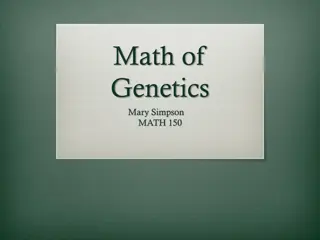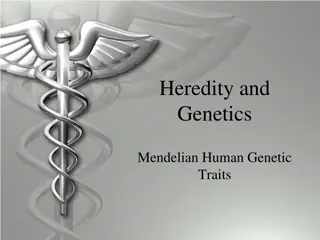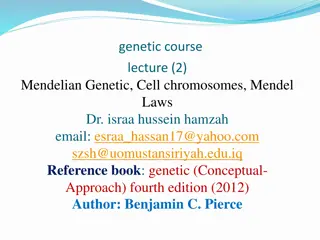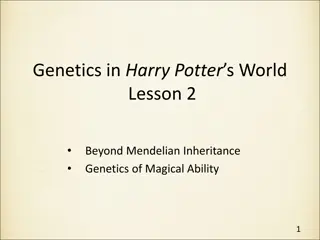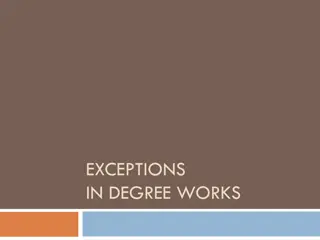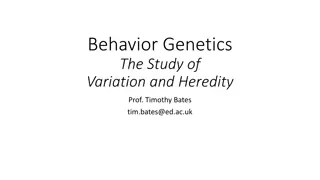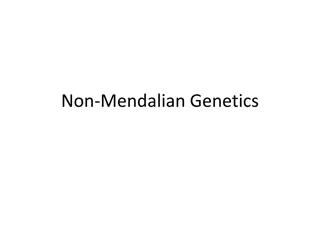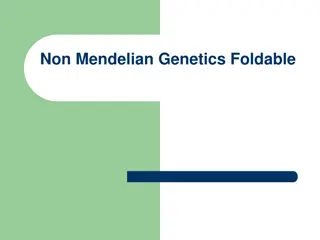Understanding Mendelian Genetics Exceptions
Explore the exceptions to Mendel's laws including incomplete dominance, codominance, and multiple alleles with detailed explanations and illustrative examples. Learn how these variations impact the inheritance of traits and genetic expressions in organisms.
Download Presentation

Please find below an Image/Link to download the presentation.
The content on the website is provided AS IS for your information and personal use only. It may not be sold, licensed, or shared on other websites without obtaining consent from the author. Download presentation by click this link. If you encounter any issues during the download, it is possible that the publisher has removed the file from their server.
E N D
Presentation Transcript
Mendelian Exceptions Mendel got lucky all 7 traits he studied showed complete (simple) dominance.
Mendelian Exceptions Mendel got lucky all 7 traits he studied showed complete (simple) dominance. One allele is completely dominant over the other allele Homozygous dominant and heterozygous = same phenotype 1 allele is enough for full expression of dominant trait
Incomplete Dominance = the norm Heterozygote = intermediate phenotype 1 allele is not enough for full expression
Incomplete Dominance Ex: flower color R = red RR x rr r = white
Incomplete Dominance F2: Rr x Rr
Incomplete Dominance F2: Rr x Rr RR Rr 1 red 2 pink 1 white Rr rr Alleles not blended still able to separate.
Codominance Both alleles are expressed equally
Codominance Both alleles are expressed equally Ex: Cows B = black W = white BB = Black WW = White BW = ???
Codominance Both alleles are expressed equally Ex: Cows B = black W = white BB = Black WW = White BW = Black and white Other examples: calico cats, streaked flowers
Multiple alleles Allele: Alternate forms of a gene Only 2 possible alleles in an individual, BUT any # of alleles may be present in a population due to mutations
Blood Types (ABO blood types) Example of simple dominance, codominance, and multiple alleles
Blood Types (ABO blood types) Example of simple dominance, codominance, and multiple alleles Alelles = A, B, O A & B = Dominant O = Recessive
Blood Types (ABO blood types) Example of simple dominance, codominance, and multiple alleles Alelles = A, B, O A & B = Dominant O = Recessive Genotype Phenotype AA
Blood Types (ABO blood types) Example of simple dominance, codominance, and multiple alleles Alelles = A, B, O A & B = Dominant O = Recessive Genotype Phenotype AA A
Blood Types (ABO blood types) Example of simple dominance, codominance, and multiple alleles Alelles = A, B, O A & B = Dominant O = Recessive Genotype Phenotype AA AO A
Blood Types (ABO blood types) Example of simple dominance, codominance, and multiple alleles Alelles = A, B, O A & B = Dominant O = Recessive Genotype Phenotype AA AO A A
Blood Types (ABO blood types) Example of simple dominance, codominance, and multiple alleles Alelles = A, B, O A & B = Dominant O = Recessive Genotype Phenotype AA AO BB A A
Blood Types (ABO blood types) Example of simple dominance, codominance, and multiple alleles Alelles = A, B, O A & B = Dominant O = Recessive Genotype Phenotype AA AO BB B A A
Blood Types (ABO blood types) Example of simple dominance, codominance, and multiple alleles Alelles = A, B, O A & B = Dominant O = Recessive Genotype Phenotype AA AO BB BO B A A
Blood Types (ABO blood types) Example of simple dominance, codominance, and multiple alleles Alelles = A, B, O A & B = Dominant O = Recessive Genotype Phenotype AA AO BB BO B B A A
Blood Types (ABO blood types) Example of simple dominance, codominance, and multiple alleles Alelles = A, B, O A & B = Dominant O = Recessive Genotype Phenotype AA AO BB BO AB B B A A
Blood Types (ABO blood types) Example of simple dominance, codominance, and multiple alleles Alelles = A, B, O A & B = Dominant O = Recessive Genotype Phenotype AA AO BB BO AB B B AB (codom.) A A
Blood Types (ABO blood types) Example of simple dominance, codominance, and multiple alleles Alelles = A, B, O A & B = Dominant O = Recessive Genotype Phenotype AA AO BB BO AB OO B B AB (codom.) A A
Blood Types (ABO blood types) Example of simple dominance, codominance, and multiple alleles Alelles = A, B, O A & B = Dominant O = Recessive Genotype Phenotype AA AO BB BO AB OO B B AB (codom.) O A A
Q: What combination of parents have an equal chance of having any of the 4 blood types?
Q: What combination of parents have an equal chance of having any of the 4 blood types?
Mexican Hairless Dogs Hairless (H) is completely dominant over hairy (h). When two hairless are crossed: 2/3 hairless 1/3 hairy Why???
Mexican Hairless Dogs Hairless (H) is completely dominant over hairy (h). When two hairless are crossed: 2/3 hairless 1/3 hairy
Mexican Hairless Dogs Hairless (H) is completely dominant over hairy (h). When two hairless are crossed: 2/3 hairless 1/3 hairy HH Hh Hh hh
Mexican Hairless Dogs Hairless (H) is completely dominant over hairy (h). When two hairless are crossed: 2/3 hairless 1/3 hairy HH Hh Hh hh
Lethal Allele 2 copies of a lethal allele = death (usually stillborn) Hint: if offspring ratio is x/3, think lethal allele (someone is dying)
Lethal Allele Q: How can we breed hairless dogs without stillborns?
3, 4, 5, etc. trait crosses If a pea plant that is TTRrPp is crossed with a plant that is TtrrPp, what percent of the offspring will be heterozygous for all three traits?
If a pea plant that is TTRrPp is crossed with a plant that is TtrrPp, what percent of the offspring will be heterozygous for all three traits? Is there an easier way???
Product Rule Make a simple 4 square cross for each trait, then multiply the results for each TT TT Rr Rr PP Pp Tt Tt rr rr Pp pp
Epistasis The process of one gene controlling the expression of another An epistatic gene can completely mask the effects of another gene 2 genes -> 1 trait
Example: Lab Fur Color 2 genes are responsible for fur color: Black-brown gene Pigment gene
Example: Lab Fur Color 2 genes are responsible for hair color: Black-brown gene Pigment gene Pigment gene is epistatic (controls the expression of) over the Black-brown gene
Polygenic Inheritance Most traits (especially visible ones) are due to the interaction of multiple proteins, thus multiple genes As such, most traits do not follow simple Mendelian ratios


